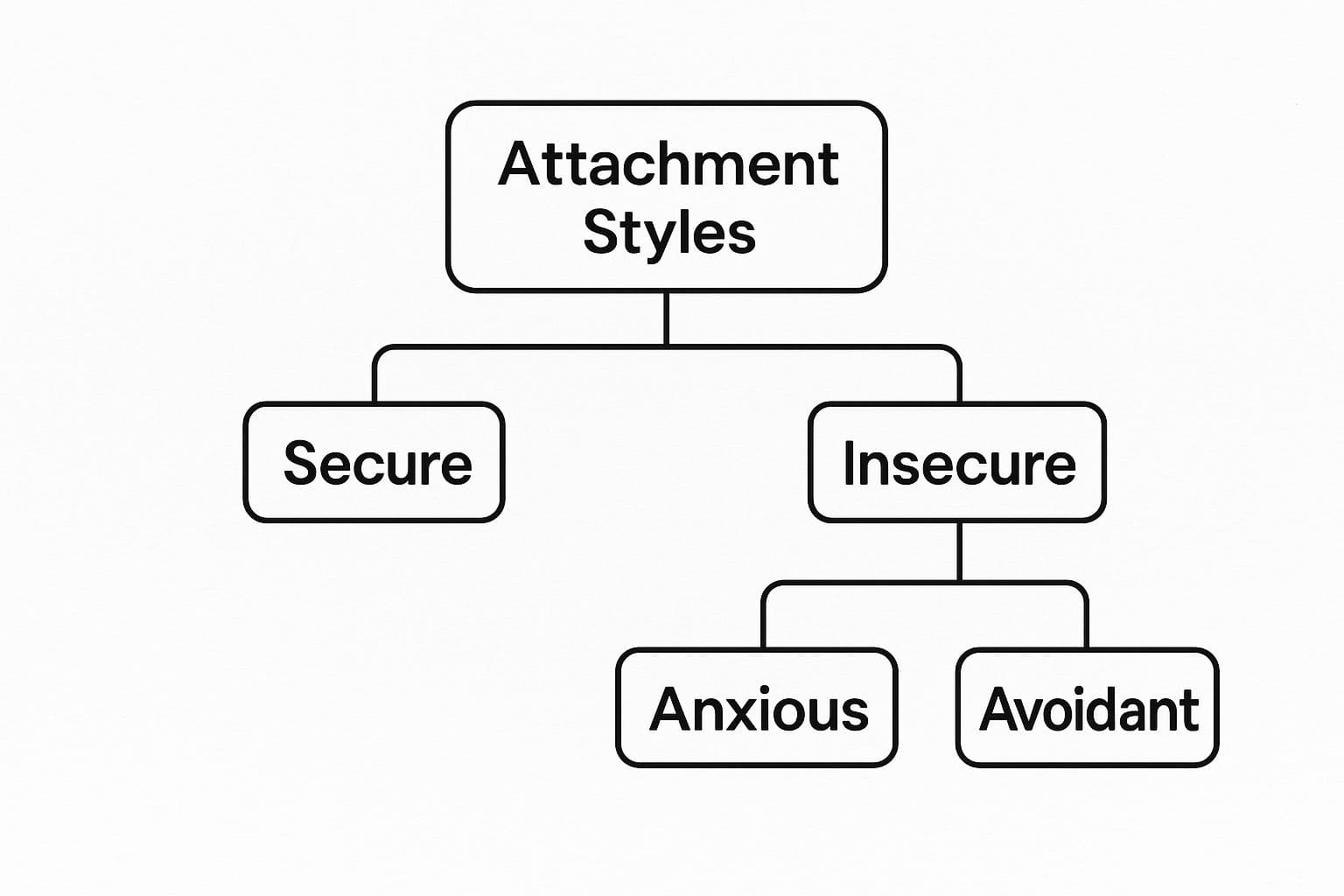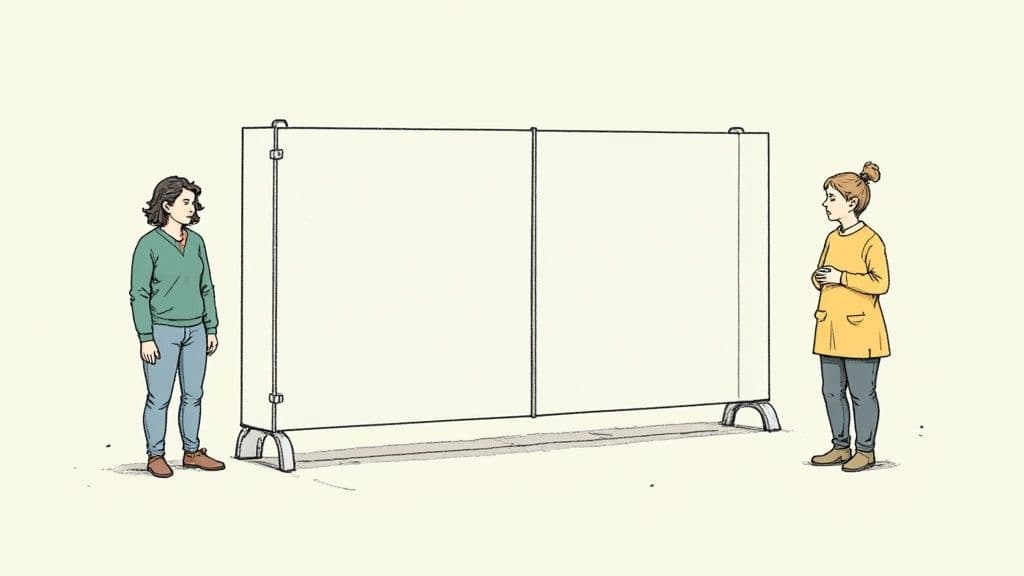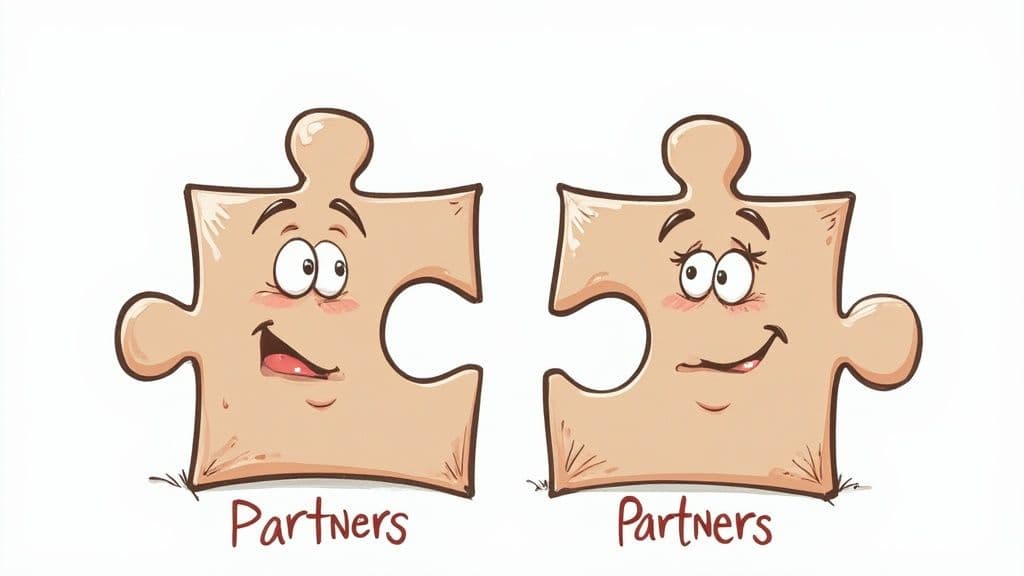Have you ever noticed the same argument replaying in your relationship, or wondered why one partner wants closeness while the other withdraws? Those repeating patterns are often rooted in attachment styles — the internal map you developed for how relationships work. This guide breaks down the four main attachment styles, where they come from, how they show up in everyday conflict, and clear, practical steps to move toward greater security.
September 6, 2025 (3mo ago) — last updated December 16, 2025 (5d ago)
Attachment Styles in Relationships: Practical Guide
Discover the four attachment styles, how they form, and practical steps to build more secure, healthier relationships.
← Back to blog
Attachment Styles in Relationships: A Practical Guide
Summary
Learn how attachment styles shape your relationships, how they form, and practical steps to build a more secure bond.
Introduction
Have you ever noticed the same argument replaying in your relationship, or wondered why one partner wants closeness while the other withdraws? Those repeating patterns are often rooted in attachment styles — the internal map you developed for how relationships work. This guide breaks down the four main attachment styles, where they come from, how they show up in everyday conflict, and clear, practical steps to move toward greater security.
Your Relational Blueprint: What Is It?
An attachment style is the relational map you built in childhood from how caregivers responded to your needs. Were they reliable and comforting, or inconsistent and distant? Those early interactions shape what you expect from others and how you behave when you feel vulnerable.
Understanding your attachment style isn’t about assigning blame. It’s about gaining clarity so you can choose different responses today.
Why this matters
Understanding attachment gives you practical benefits:
- It helps decode recurring patterns so you can break unhealthy cycles.
- It creates compassion for your partner by showing behavior as learned survival strategies.
- It offers a roadmap for change so you can intentionally build healthier, more secure bonds.
By exploring the four main styles — secure, anxious-preoccupied, dismissive-avoidant, and fearful-avoidant — you’ll get the insight you need to improve your relationships.
The Four Core Attachment Styles Explained
Attachment styles sit on a spectrum defined by two factors: comfort with closeness (avoidance) and anxiety about abandonment. At a broad level, patterns split into secure and insecure, with insecure styles commonly described as anxious, avoidant, or fearful.

Secure: The Anchor
People with a secure attachment balance intimacy and independence. They feel comfortable giving and receiving love and tend to hold a positive view of themselves and others. In conflict, they can express needs and listen without spiraling into fear or shutting down. A majority of adults are categorized as secure in large-scale reviews of attachment research1.
Anxious-Preoccupied: The Wave Watcher
Anxious-preoccupied people long for deep connection but worry about abandonment. They often have a negative view of themselves and may amplify emotional signals to stay close. Anxiety shows as reassurance-seeking, rumination about small signs, and escalation when they sense distance.
Dismissive-Avoidant: The Lone Sailor
Dismissive-avoidant individuals value independence and may suppress emotions to avoid vulnerability. They usually feel positive about themselves but skeptical of others, keeping relationships surface-level and withdrawing when intimacy rises.
Fearful-Avoidant (Disorganized): The Conflicted Traveler
Fearful-avoidant attachment combines a desire for closeness with a fear of being hurt. People with this style often hold negative views of themselves and others, resulting in unpredictable push-pull behavior that can trace back to frightening or chaotic early experiences.
Quick Guide to the Four Attachment Styles
| Attachment Style | View of Self & Others | Behavior in Relationships | Core Fear |
|---|---|---|---|
| Secure | Positive view of self and others | Balances intimacy and independence; communicates needs effectively | Trusting connection |
| Anxious-Preoccupied | Negative view of self, positive view of others | Seeks high intimacy and approval; can be clingy | Abandonment and rejection |
| Dismissive-Avoidant | Positive view of self, negative view of others | Emotionally distant; values independence highly | Losing independence or being controlled |
| Fearful-Avoidant | Negative view of self and others | Desires intimacy but fears it; unpredictable push-pull | Getting too close and being abandoned |
These categories describe common patterns, not fixed labels. Recognizing your dominant style is the first step toward change.
How Your Attachment Blueprint Is Formed

Attachment isn’t innate. It’s a learned survival map shaped by thousands of small interactions in childhood. When you expressed need, how did caregivers respond? Consistent comfort teaches you that connection is safe; inconsistent or frightening care teaches you to protect yourself.
Building a secure foundation
Secure attachment grows from consistent, attuned caregiving. When a child’s needs are met reliably, they internalize the message: “You are safe. Your needs matter.” That sense of safety becomes a foundation for healthier relationships later in life.
How insecure styles originate
Insecure patterns develop when caregiving is inconsistent, emotionally distant, or frightening. These adaptations are survival strategies, not character flaws.
- Anxious attachment often comes from inconsistent responsiveness, teaching the child to amplify signals to stay connected.
- Avoidant attachment can arise when emotional expression is discouraged or ignored, teaching self-reliance as protection.
- Disorganized attachment often stems from caregivers who are also a source of fear, creating an unresolvable approach–avoid conflict.
Understanding origin stories encourages compassion and choice: these patterns are understandable responses, and they can change.
How Attachment Styles Play Out in Your Relationship

Attachment patterns show up most clearly during conflict. The same disagreement can unfold very differently depending on each partner’s style. A common dynamic is the anxious-avoidant cycle: one person pursues closeness while the other withdraws to protect autonomy, creating a loop where neither partner gets their needs met.
Example:
- Alex (anxious): “Hey, is everything okay? You seem distant. Did I do something?”
- Jordan (avoidant): “I’m fine, just tired. I need some space.”
- Alex (escalating): “Space? You always want space! It feels like you’re pushing me away.”
- Jordan (withdrawing): “I can’t do this right now. I just need to be alone.”
This pattern fuels both partners’ core fears—abandonment for the anxious partner and loss of autonomy for the avoidant partner.
Conflict through different attachment lenses
- Secure + Secure: Both partners can name their feelings and repair the rupture starting from trust.
- Anxious reaction: A forgotten plan can feel catastrophic and trigger escalation.
Recognizing these reactive patterns is the first step toward empathy. When you see behavior as a survival response, you can meet each other’s underlying needs instead of reacting to surface threats.
The Hidden Impact of Your Attachment Style
Attachment is like an operating system running in the background of your emotional life. It shapes friendships, mental health, and self-worth. Insecure styles often create a low-level emotional strain—chronic vigilance for anxious people and quiet loneliness for avoidant people.
Research links secure attachment with lower rates of depression and social anxiety, while insecure styles are associated with greater emotional symptoms in young people2.
Understanding this link changes the goal from “fixing” a flaw to practicing self-care that strengthens your inner life and relationships.
How to Build a More Secure Attachment

The encouraging truth is that attachment styles are adaptable. Developing “earned security” means building the safety and trust you may not have consistently received early on. The aim is for relationships to become a source of comfort rather than constant activation of fear.
Start with self-awareness
Notice what triggers your attachment system — the moments when anxiety spikes or you feel the urge to withdraw. Pause and ask:
- What happened that made me feel this way?
- What story am I telling myself right now?
- What deep fear is being activated?
Mapping your triggers helps you respond thoughtfully instead of automatically.
Develop clearer communication skills
Practice expressing needs calmly. Use “I” statements to name your experience without blaming, for example: “I felt hurt when our plan changed.” This reduces defensiveness and opens space for repair. For practical guidance, see resources on healthy relationship communication at /healthy-communication.
Learn to self-soothe
Regulating your own emotions reduces pressure on your partner to always calm you. Simple tools — deep breathing, short walks, or journaling — help ground you. Therapies like Emotionally Focused Therapy have strong evidence for helping couples heal attachment wounds3.
Working toward security takes compassion and practice. Over time, small steps add up to lasting change.
For more tools to build clarity and better relationships, explore resources on self-soothing (/self-soothing-techniques) and communication skills (/healthy-communication). Try a short self-check quiz at /attachment-quiz to identify patterns and next steps.
Frequently Asked Questions
What is an attachment style and why does it matter?
An attachment style is your learned pattern for relating to others, formed in childhood. It matters because it shapes how you handle closeness, conflict, and trust in relationships.
Can attachment styles change?
Yes. Through self-awareness, new communication skills, self-soothing, and supportive therapy, people can move toward more secure ways of relating.
How do I know my attachment style?
Notice your patterns under stress: Do you seek reassurance (anxious), shut down (avoidant), move between both (fearful), or stay balanced (secure)? For a deeper assessment, try trusted attachment questionnaires or talk with a therapist.
Quick Q&A
Q: How do I stop the anxious-avoidant cycle with my partner? A: Name your pattern, set a calm boundary (for example, request a 20-minute pause rather than withdrawing for hours), and follow up with a clear check-in when you’re regulated.
Q: What everyday habits help build earned security? A: Regular self-soothing, consistent honest check-ins with your partner, and small acts of reliability — showing up when you say you will — reinforce safety over time.
Q: When is professional help a good idea? A: Seek therapy if patterns cause ongoing distress, feel linked to past trauma, or block intimacy despite consistent effort. Couples therapy that focuses on attachment can be especially helpful.
Discover Your Life Purpose Today!
Unlock your true potential and find your life’s purpose.
